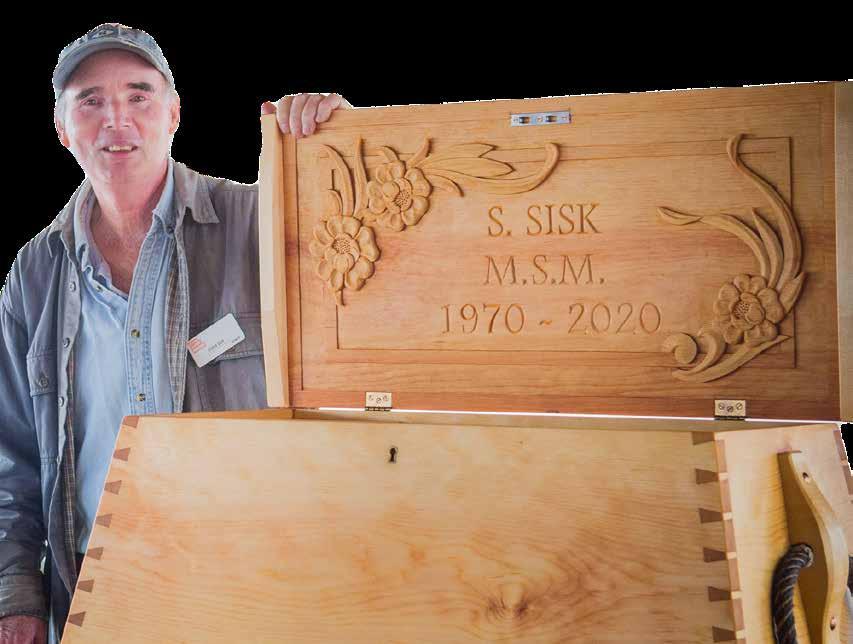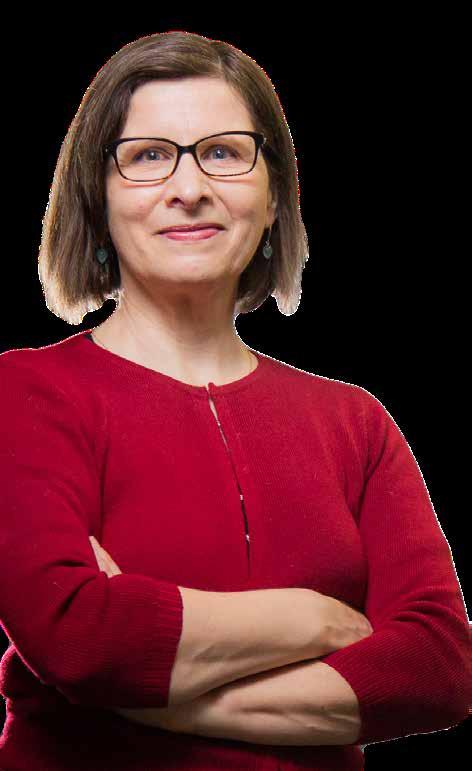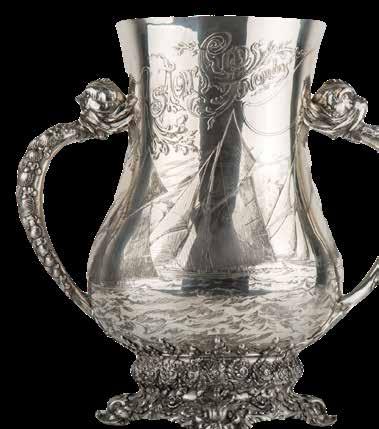
12 minute read
FAREWELL SUSAN FUNK
he COVID-19 pandemic has imT pacted every aspect of our lives, including how we honor members of the Museum family at milestones in their lives during this time of strict social-distancing protocols. Such was the case with the Museum’s recent drive-by parade on the Museum grounds and a virtual farewell tribute, attended by hundreds of Museum staff, friends, and family, who gathered to honor the distinguished career of Susan Funk, executive vice president and chief operating officer, who retired in June after 40 years of dedicated service to the Museum.
Funk’s association with the Museum began with the inaugural class of the Williams-Mystic Program in 1977. In fact, she was the very first member of the class to arrive on the grounds due to her father’s urging that she be punctual. This was the first of many “firsts” for Funk. She was the first Williams-Mystic alum to join the program’s staff, the first to become a full-time staff member at the Museum, the first president of the Williams-Mystic Alumni Council, and the first recipient of the Susan Stucke Funk Alumni Distinguished Service Award in 1997. Funk was an early and tireless advocate behind the Campaign for Williams-Mystic, which culminated in the construction of the James T. Carlton Marine Science Center and renovation of the student houses.
Advertisement
Funk held a record 12 different job titles during her years at the Museum. In these various capacities, she came to know the Museum as both student and teacher, leader and guide, captain and mate. She interpreted exhibits, split fish, hoisted sails as a “squaddie,” tried her hand at boatbuilding, chaperoned teens onboard the schooner Brilliant, went to sea with Williams-Mystic, and participated in the Munson Institute. In perhaps her final “first,” Funk was the first woman to be appointed executive vice president of Mystic Seaport Museum, a position she held until her retirement. Funk’s devotion to experiential learning grew along with the Museum. One of the milestones of her career was the Museum’s construction of the schooner Amistad in the Preservation Shipyard and development of the accompanying website Exploring Amistad. Funk played a central role in planning the earliest iterations of “education technology” at the Museum, planting the seeds for what would later become the Mystic Seaport for Educators website and the still-evolving virtual museum. She devoted herself to three strategic planning processes, including re-envisioning the north end of the Museum grounds and the fulfillment of that vision with the Thompson Exhibition Building and the Collins Gallery.
But of all the projects that bear her mark, the 38th Voyage of the Museum’s whaleship Charles W. Morgan and the suite of public programming that accompanied this epic voyage exemplifies the tenets of her 40-year career. The program was honored with a prestigious National Endowment for the Humanities Chairman’s Award.
During the Zoom tribute, accolades and reflections from far and wide characterized Funk’s contributions as a leader, her trusted presence as a colleague, mentor, and friend, and her dedication to the Museum’s core values. Board Chairman Michael Hudner mused that Funk and Mystic Seaport Museum “share the same DNA.” Fellow Williams-Mystic alums reminisced about unauthorized climbs to the crow’s nest of the Charles W. Morgan under cover of darkness and former staff recalled long-ago whaleboat rowing escapades to Fisher’s Island, fortified by beer.
Dr. James T. Carlton, former director of the Williams-Mystic Maritime Studies Program, recounted how Susan Stucke, a junior and American History major at Bates College, learned about a new studyaway semester called the Williams College-Mystic Seaport Program in American Maritime Studies. Carlton recently located her application, dated January 7, 1977, in the program’s archival admissions files and read from it during the Zoom tribute. In her application, the 20year old Susan Stucke wrote, “I am interested in pursuing museum work as a career.” Carlton added, “Clearly, any dictionary definition of ‘focus’ should have Susan’s picture next to it. While Susan’s friends and colleagues know her as a true polymath, few may know that she first planned to major in biology at Bates. What marine biology lost, Mystic Seaport Museum and Williams-Mystic gained for more than four decades.”
At the close of Funk’s tribute, Museum President Steve White unveiled a photo of the façade of the newly renamed Susan Stucke Funk Children’s Museum, adorned with a hand-carved wooden sign proudly bearing the building’s new name, in honor of her extraordinary contributions to this Museum.
Mayflower II, the 64-year-old historic reproduction of the ship that brought the Pilgrims to the shores of what would become Massachusetts in 1620, departed the Museum’s Preservation Shipyard on July 20 to begin the voyage to its homeport of Plymouth.
The ship had been undergoing an extensive restoration in the Shipyard since November 2016.
Designed by MIT-trained naval architect William Avery Baker for Plimoth Plantation, Mayflower II was built in Brixham, England, beginning in July 1955. Intended as a gift to the people of America from the people of England to honor the bonds of friendship formed during World War II, it arrived under sail to Plymouth, MA, on June 13, 1957, and since then has been a major exhibit of Plimoth Plantation. Millions of visitors have crossed the decks to learn about the Pilgrims’ historic journey and 17th-century maritime life.
For the restoration, skilled shipwrights from Mystic Seaport Museum worked alongside Plimoth’s maritime artisans to fully restore the ship according to the Secretary of the Interior’s Standards for Historic Vessel Preservation Projects. Nearly 70 percent of the ship’s timbers, planking, structural frames, knees, and beams were replaced, using six types of wood from eight states and from as far away as Denmark. Seaworthy once again, the ship was launched into the Mystic River and re-christened on September 7, 2019.
The ship’s first stop was New London, where Mayflower II docked at City Pier for about two weeks so the crew could conduct sea trials to test the ship’s performance and perform sail training to ensure safe operation while underway. The ship eventually returned to Plymouth for a grand homecoming. Although the COVID-19 pandemic cancelled a voyage to Boston, Plimoth officials say the ship will sail again.
MAYFLOWER II SAILS AGAIN
MUSEUM HOSTS A FREEDOM FORUM

“Why are conversations about race so difficult?” ? MUSEUM NEWS
Systemic racism and finding ways to fight it was the build an effective, inclusive and sustainable committopic of a “Freedom Forum” hosted by Mystic Seaport ment to eliminate systemic racism in our communiMuseum and Discovering Amistad the evening of Au- ties?” The panelists were Danielle Chesebrough, first gust 20. Formally titled, “The Freedom Forum: A Series selectwoman, Town of Stonington; Mary Anne Butler, of Courageous Conversations on Race, Privilege, Op- assistant superintendent, Stonington Public Schools; pression and Justice in America for the Town of Ston- and Pastor Joseph Coleman, St. John’s Christian ington, the Town of Groton and the City of Groton,” the Church, Groton. Troy Brown, Discovering Amistad board event gathered more than 80 municipal officials and member, acted as the Forum moderator and posed community leaders from the local area to address the questions such as “Why are conversations about issue of systemic racism. race so difficult?” and “Do you This was the first of what Discovering Amistad intends “Stand up for what you think about race every day?” Panelists shared their thoughts to be a series of Forums held in different towns and cities believe. Because in the final and experiences with the common acknowledgement that confrontacross Connecticut. The event began with key- analysis, we are one family, ing racism is a long journey and there is no easy answer. “We have note remarks by Connecti- the human family.” to have these conversations with cut Supreme Court Chief each other to build a foundation of Justice Richard A. Robinson, comfort and honesty,” said Butler. who told the crowd, “It’s as if the country is at a cross- “We have a lot to do, but I am glad we started.” roads and what we do at this moment will determine The event concluded with Antonia Wright, a young whether we are finally going to live up to America’s graduate of the Amistad Academy reading quotes by ideals of equality and true justice for all, or forfeit them the late U.S. Rep. John Lewis, who observed “Stand up to the dustbin of history.” for what you believe. Because in the final analysis, we
Justice Robinson’s remarks were followed by a pan- are one family, the human family.” el discussion with local leaders about the realities of racism, privilege, oppression and bias in our commu- To learn more about Discovering Amistad, please visit nities. The topic for discussion was “In the wake of discoveringamistad.org. centuries of oppression and a summer of events demanding justice and triggering protest, how do we
50 YEARS IN THE GARDEN WITH STEVE SISK
One morning this October, a group of socially distant well-wishers gathered in the Claggett Boat Shed to honor Museum gardener Steve Sisk for his five decades of service.
Sisk’s first day at the Museum was June 1, 1970. He was 17 years old and his parents had to attest in writing that he was old enough to be hired. Sisk joined the staff as a gardener and has worked in that capacity ever since.
Sisk is a familiar face around the grounds, known for his cheerful hello and the particular care he provides to all of the plants in his charge. “Steve is a remarkable worker, gardener, and friend,” Museum President Steve White told the assembled crowd, many of whom were not even alive when Sisk started at the Museum.
The Museum presented Sisk with a sea chest, hand-crafted by staff members. The woodwork was done by shipwright Trevor Allen, an intricate carving under the lid was designed by Arleen Andersen and carved by Richard Froh and Jeff Rossie, and the knotwork beckets for the handles were produced by rigger Sarah Clement.
The sea chest was presented with “pleasure, pride, and affection,” said White.
And no, Steve Sisk is not retiring. You will continue to see him, rake in hand, caring for the plants across the campus as he has for the last 50 years.

THE TREWORGY PLANETARIUM LEADS THE WAY By Brian Koehler
This past spring, planetariums across the country were among the many places of public gathering that were forced to close their doors. Following the difficult decision to close the Museum temporarily, the Education Department was tasked with the challenge of finding a way to continue to engage students, special-interest groups, and the public. April and May saw a rapid pivot to distance learning, as we converted our most popular school programs to virtual offerings for a wider audience. While working from home studios, we began to brainstorm towards the slow, gradual reopening of the Museum, and what role the Planetarium might play.
We knew that the initial phases of the Museum’s reopening would involve outdoor access only, with no indoor exhibit use. As we explored possible outdoor activities on the subjects of astronomy and navigation, we quickly realized that any programs we could offer would need to meet certain criteria: Could the activity be done while keeping visitors socially distanced? Could all materials be cleaned, and/or single-use recyclable? Could it occur in varying types of weather?
We tried quite a few activities this past summer, but by far, our two most successful offerings were “Scaling the Solar System” and “Build a Sundial.” The former is the ultimate socially distant activity: spreading out the planets on a 200-foot-long, linear space in front of the Planetarium building. The latter proved to be a truly green craft activity, with all of the materials in our pre-made sundial kits being recyclable. The activity yielded a working sundial that visitors could take home with them.
In July, the Planetarium was able to open our doors to a reduced capacity of visitors for live shows about the night sky. We now offer 2-3 shows each day, maintaining at least six feet of distance between family units on the benches in our theater, and thoroughly cleaning the room in between shows. Through our careful planning and vigilance, we have set a new standard for planetariums in the northeast. At a recent virtual conference of the Middle Atlantic Planetarium Society, we learned that we are one of the only planetariums in the region to hold safe outdoor activities in the summer and live shows as well.

Many planetariums remain closed, but as they open, they are looking at the Treworgy Planetarium as a model for bringing people back — safely — to view the wonders of the night sky.
THE SEA AS MUSE By Katherine Hijar, Ph.D.
A youthful nude woman, personifying Victory and cast in silver, poses at the top of a neoclassical urn. Her form and the array of the details that ornament this trophy reflect Gilded Age fashions in decorative arts, a blend of ancient designs and modern interpretations. This fine specimen of artistic talent and craftsmen’s skill was awarded by the New York Yacht Club in 1895 to commemorate the victory of the yacht Defender, its captain, and its crew.
The value of this prize cup reflects the beauty of the object, its scale and heft, and the cost of both the silver and the craftsmen’s labor.
Crafted by the Gorham Company, this cup is only one of approximately 500 silver trophies in the Museum’s collection, which includes works by Tiffany & Co., Black, Starr & Frost, and the International Silver Company. In past exhibits, treasures like this one have captured visitors’ imaginations as reminders of superior vessels, captains, and crews. With the generous support of the Henry Luce Foundation, a new exhibit will highlight the decorative arts collection at Mystic Seaport Museum with an eye to understanding them as artistic expressions of forgotten craftsmen.
Until recently, we knew nothing about the craftsmen who created this Astor Cup, or, indeed, about any of the trophies in the Museum’s collection. Research in the Gorham archives at Brown University led to a remarkable discovery: the original manufacturing receipt for this cup, plus the surnames of the six skilled workers who transformed it from a 2-dimensional drawing into a 3-dimensional showpiece. The receipt—known as a costing receipt—shows the number of hours of work completed at each stage in the making of the trophy, along with the cost of materials and workers’ wages.

This find is, for historical researchers, almost akin










